Yucca Elephantipes (Spineless Yucca / Stick Yucca) – The Complete Care Guide
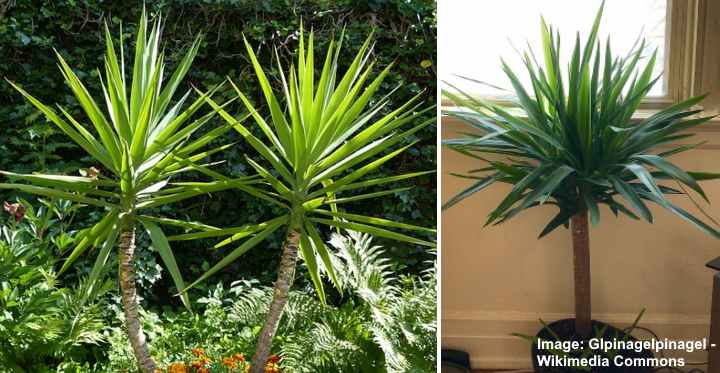
Yucca elephantipes—also called spineless yucca, stick yucca and yucca gigantea—is a type of shrubby plant with thick cane stems and sword-shaped leaves. Yucca plants grow outdoors in hot arid climates. The Yucca elephantipes is an ideal tree like houseplant because of its soft palm-like foliage, medium growth, and for its ease of care.
How to care for Yucca Elephantipes: The spineless yucca thrives growing in bright indirect sunlight, well-draining sandy soil, and a temperature range of 60°F to 80°F (15°C – 26°C). Water the cane yucca when the top layer of soil dries. Fertilize occasionally during spring and summer.
The yucca plant is a type of evergreen shrub that looks like a small tree. The tree like yucca plant has large sword like leaves, and large clusters of white flowers.
Yucca plants are a genus of flowering ornamental shrubs and trees in the family Asparagaceae. In its native habitat of Central American and the southern states of the U.S., yuccas thrive in hot, arid conditions. These hardy cane plants can withstand temperatures as low as 30°F (-1°C) and as high as 90°F (32°C).
The broad, sword-like leaves identify stick yucca (Yucca elephantipes). Its spiky foliage grows in a rosette form on the top of a bare stem or cane. To help identify this species of yucca from others, check for spines on the leaves. The leaves of stick yuccas have no spines, which is how it gets its other common name—spineless yucca.
This article is a complete care guide to growing a Yucca elephantipes at home. At the end of the article, you will find out how to resolve issues when growing this ornamental yucca as a houseplant.
Growing Yucca Elephantipes Indoors
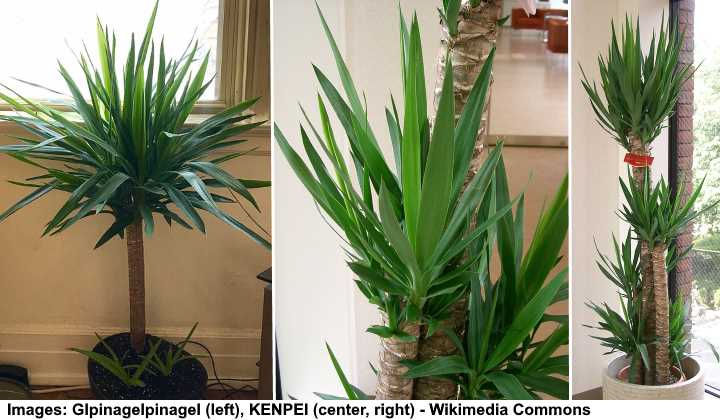
Yucca Elephantipes is a low maintenance and easy to grow houseplant
Spineless yucca plants (Yucca elephantipes) grow well indoors. The stick yucca thrives in bright light but also tolerates low light and some drought as well. This tall indoor plant is an ideal plant for brightening up any corner of a room.
Its straight upright, rigid stems with spiky green foliage add tropical elements to any room—a reason why some stores sell yuccas as “tropisk” plants. Unlike other species of yuccas that tend to have razor-sharp leaves with sharp ends, the yucca cane plant has soft foliage like a palm tree.
Spineless Yucca Flowers
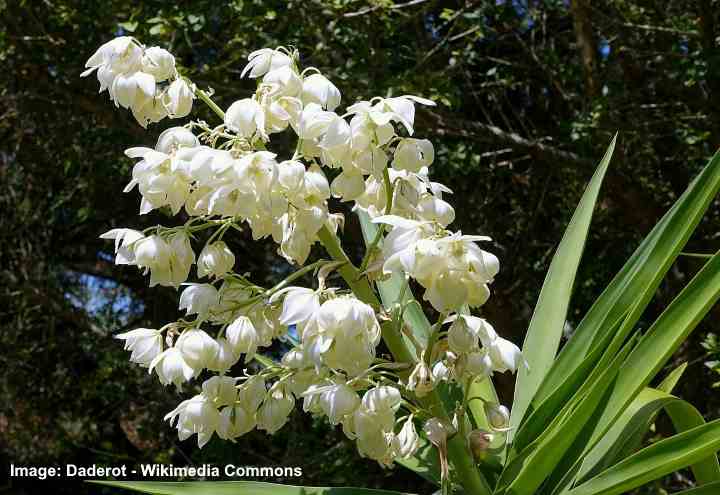
Yucca elephantipes rarely flowers when grown indoors as a houseplant
Yucca elephantipes produces a large cluster of white flowers when it blooms. The flower panicles (branched inflorescence) have a conical shape and grow from the center of the plant. Spineless yuccas usually produce flowers during spring and summer.
Stick yucca plants rarely produce any flowers when growing in pots or containers. Even in ideal growing conditions, it’s rare when Yucca elephantipes blooms indoors. However, the yucca plant is prized for its soft, spiky-looking foliage.
Yucca Elephantipes (Spineless Yucca) Care Requirements
Let’s look in more detail at how to care for spineless Yucca (Yucca elephantipes).
Light Requirements for Growing Stick Yucca Indoors
Spineless yucca plants need plenty of sunlight to thrive. The best location indoors for growing a yucca plant is near a south- or west-facing window. However, spineless yuccas will also grow well in bright, indirect sunlight. And, they will also adapt to lower light conditions.
Try to avoid putting your potted yucca plant in a dark, shaded location. Even though yuccas are plants that can survive in poor light, their growth will be stretched and foliage sparse. Inadequate light can also make the leaves turn yellow and then brown.
The Ideal Potting Soil for Yucca Elephantipes
Grow stick yuccas in a sandy, well-draining potting soil. Yucca plants grow outdoors in arid deserts and loose, infertile soil. An ideal potting mix for growing yuccas in containers is one-part regular potting soil with three-part perlite and coarse sand. Excellent drainage is the main soil requirement for yuccas.
To improve drainage and aerate the soil, you can also add pebbles to the potting mix.
Although you can use a potting media for succulents or cacti, it may be too rich for yucca plants. Also, spineless yuccas tend to require better drainage than succulents.
The best potting soil for growing yucca plants indoors contains horticultural soil, lava gravel, and some leaf mold or compost. Just ensure that water drains freely from holes in the pot’s base.
How to Water Spineless Yucca Houseplants
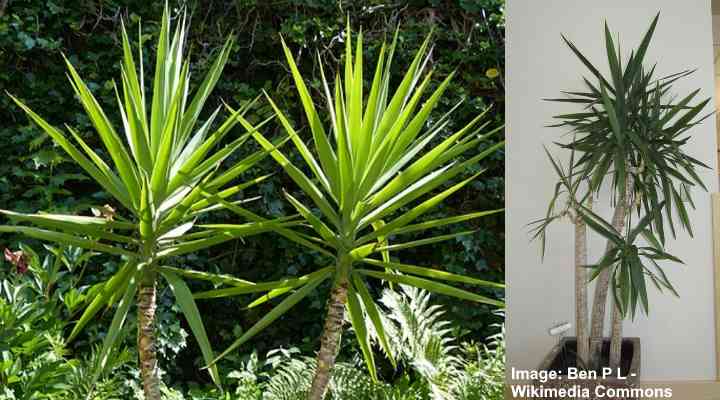
To properly care for your yucca elephantipes houseplant, only water it when the soil dries out
Only water Yucca elephantipes as often as the soil dries out. In bright sunshine and hot temperatures, a yucca may need watering weekly. In colder weather, less often—maybe as infrequently as every other month. But always let soil moisture be your guide before watering your plant.
Similar to many types of succulents, spineless yuccas are drought-resistant plants. The yucca cane will grow better if you water them less often rather than too frequently. Yucca plants that sit in damp, soggy soil often succumb to root rot.
To water a stick yucca, thoroughly drench the soil until it drains from the pot’s base. Allow all the excess water to drain out before putting the yucca plant pot back in its bright location. Deep hydration allows the roots to get all the nourishment they need for healthy plant growth.
Yucca Elephantipes Temperature Range for Healthy Growth
Spineless yucca plants thrive indoors in average room temperatures. One of the benefits of growing yuccas as a houseplant is that they handle temperature changes well. Yuccas grow just as well in 90°F (32°C) as they do in 30°F (-1°C).
Growing outdoors, the Yucca elephantipes thrives in USDA zones 9 – 11. Yuccas are excellent desert plants well-suited to the desert climate. A spineless yucca will survive 30°F (-1°C) during freezing nights but continue to grow well when the daytime temperature reaches 90°F (32°C).
Humidity Requirements for Growing Stick Yucca
Spineless yucca plants need medium humidity. In general, average household humidity is ideal, so you don’t need to mist yucca cane plants or use a humidifier. You may notice that if air moisture levels are excessively low, brown tips could appear on the leaves.
Too much humidity can result in fungal diseases and leaf spots. However, excessive humidity is only usually a problem during cold winter months if there is too much moisture in the air.
Yucca Elephantipes Growth Rate
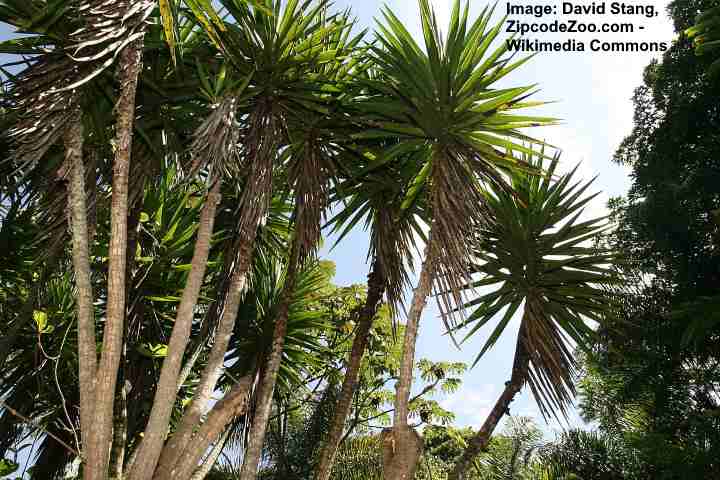
When grown outdoors, yucca Elephantipes can reach 20 ft. (6 m) high
Spineless yucca cane plants have a fast growth rate under ideal conditions. According to botanists, a Yucca elephantipes grows at a rate of 24” (60 cm) per year. At maturity, the yucca tree can reach 20 ft. (6 m) outdoors and have a spread of up to 15 ft. (4.5 m).
Growing indoors, a potted yucca has a slower growth rate. You can expect the cane plant to grow at around 6” to 12” (15 – 30 cm) per year. An indoor spineless yucca will grow to about 5 ft. (1.5 m) after several years. However, pruning the top off the yucca stem can help control its growth.
Feeding Stick Yucca Plants
Use a diluted cactus fertilizer every two to three months to feed a spineless yucca during the growing season. However, due to their slow growth indoors and their ability to thrive in poor soil, fertilization isn’t always necessary. If you choose to fertilize your yucca, select a low-nitrogen, balanced fertilizer.
In many cases, growing a yucca plant in optimal indoor conditions eliminates the need for extra feeding. For healthy growth, the Yucca elephantipes should grow in well-draining loamy soil, with occasional watering, and placed in a bright location.
Related: The Best Indoor Plant Fertilizers
How to Prune Spineless Yucca Plants
Stick yucca plants don’t require much pruning, making them low-maintenance houseplants. The only type of pruning you may have to do is trim any drooping leaves. Snipping off the bottom leaves will give the yucca plant an appearance of upward growth. You should also prune any dead or damaged leaves.
You can also chop the top off a spineless yucca to reduce its height. You can either cut the stem at its half-way point or prune off the top of the plant by cutting about 4” (10 cm) below the leaves. Either way, you will have two stem cuttings to use for yucca propagation
Yucca Elephantipes Propagation
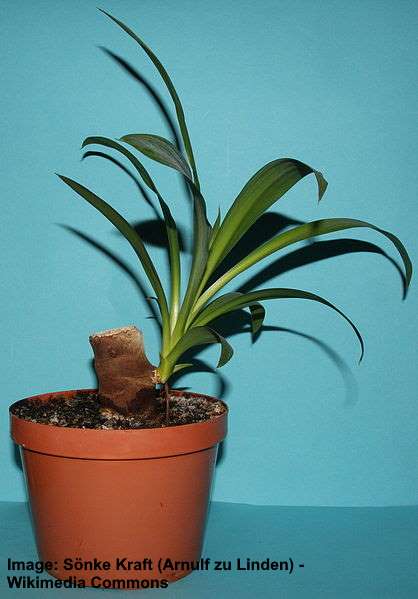
Yucca elephantipes can be easily propagated by stem cutting
To propagate a stick yucca, cut the stem using a sharp clean saw. Cut the leafy top, keeping at least 4” (10 cm) on the stem. Trim off the bottom leaves. Allow the cut yucca stem to dry for a few days. Place the stem cutting in some potting soil to propagate it.
Keep the propagated yucca plant in indirect light and keep the soil slightly moist. After three to four weeks, roots should appear at the base of the stem. Once the propagated stem is rooted, place in a bright location and look after as usual.
You can also propagate a Yucca elephantipes by cutting the stem in half. Allow the cut yucca top to dry before planting in potting soil. The stem remaining in the pot should grow a new rosette of shiny broad yucca leaves.
Repotting Yucca Elephantipes Indoor Plants
Repot stick yuccas in spring. Water the plant thoroughly the day before repotting. Gently ease the root ball from the container and remove excess dirt from the roots. Put the plant in a slightly larger pot and fill with soil, ensuring the plant grows at the same height as before.
Repotting tips when growing Yucca elephantipes indoors:
- Yucca plants prefer being slightly root bound, so you only have to repot them occasionally.
- Keep the plants in a shady location for two weeks to prevent stress and to allow them to adjust.
- Wear protective clothing to prevent sharp leaves of some yucca species from damaging your skin.
Pests Affecting Yucca Elephantipes Growth
Spineless yucca plants are hardy houseplants that rarely have problems with houseplant bugs. The most common pest on yuccas growing indoors or outdoors are aphids, mealybugs, or scale insects. Learn how to spot the early signs of pest infestations to prevent pests from killing your plants.
- Aphids on yuccas—Aphids are crawling and flying pests that can destroy your prized yucca plants. These pesky insects look like small green or black flies feeding on yucca leaves. Find out how to get rid of aphids on houseplants.
- Mealybugs on yuccas—Mealybugs leave behind a sticky honeydew on yuccas, as well as a fuzzy cotton wool-like substance. Use rubbing alcohol to get rid of mealybugs for good.
- Scale on yuccas—Scale insects look like bumpy growths on woody yuccas stems. These sap-sucking bugs will eventually weaken your yucca plant, making it susceptible to disease. Make a natural neem oil spray to eradicate scale from yucca plants.
Diseases Affecting Yucca Elephantipes Growth
Root rot is the only disease to affect spineless yucca plants. Proper watering techniques are the best way to prevent yucca root disease. If you notice signs of root rot—yellow leaves, soft stems, or leaning stems—repot your Yucca elephantipes in fresh, sterile potting soil. Only water the yucca when the soil dries out.
Are Yucca Elephantipes Plants Toxic?
Yucca plants are toxic to cats, dogs, and other house pets. The American Society for the Prevention of Cruelty to Animals (ASPCA) says that animals ingesting parts of yucca plants can experience vomiting.
Although yucca plants are mildly poisonous to humans, more injuries occur due to the yucca plant’s razor-sharp blades. Although Yucca elephantipes have softer leaves than many landscape yuccas, it’s still advisable to wear gloves when handling the spiky plants.
Problems Affecting Growing Yucca Plants
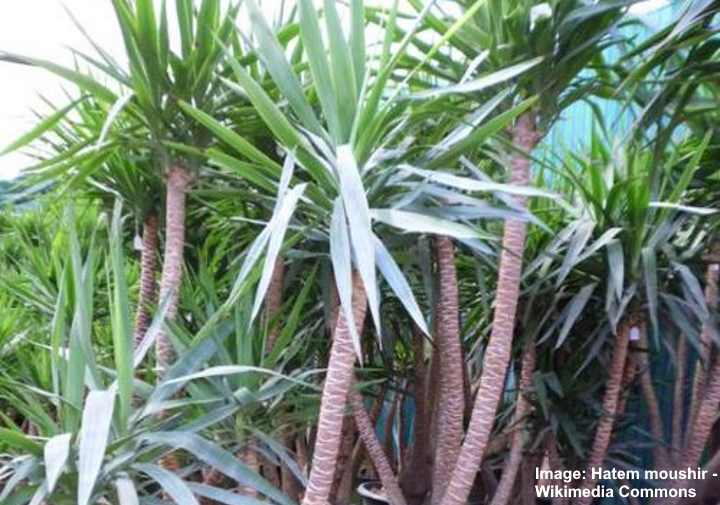
Why are yucca plant leaves wilting?
Improper watering usually causes wilting or drooping yucca elephantipes leaves. Too much water can cause the roots to rot and develop fungal diseases. To prevent drooping leaves when growing yuccas in containers, always allow the potting soil to dry between watering.
Why are spineless yucca plant leaves turning yellow?
If your spineless yucca’s leaves start yellowing, it could be due to water or light issues. Waterlogged soil or dense potting mix result in too much moisture. The result is that roots start to rot, and the leaves turn yellow.
Yellow yucca leaves could also mean too little light. Spineless yucca plants thrive in bright light and can withstand some direct sunlight. If you are watering your yucca plant properly and the leaves have started yellowing, move the cane plant to a brighter location.
What do brown leaves on a stick yucca mean?
Brown leaves on a Yucca elephantipes could indicate any of the following issues:
- Normal aging—Don’t worry if the lower leaves on the foliage crown become brown as this is just old leaves dying off.
- Poor lighting—Brown leaves on the top of your spineless yucca could indicate a severe lack of light. Put the yucca plant pot in a brighter location, but protected from direct sunlight.
- Too much water—Succulent-like plants such as yuccas don’t need much water. Soggy roots will result in wilted growth, yellow leaves, and eventually brown dead foliage.
- Mineral toxicity—A buildup of harmful minerals such as salt or fluoride can result in brown leaf tips. Flush the soil to remove the excess minerals and only water yuccas with rainwater or filtered tap water.
Why spineless yucca plants lean over?
As cane yucca plants grow tall, they can become top-heavy. Also, any problems affecting their roots or growth—root rot or excessive drought—will cause the yucca plant to lean over. To resolve the issue, cut off the yucca plant’s top about 2” below the lowest leaves. Plant in fresh potting soil.
Do yucca cane plants purify the air?
Some studies suggest that Yucca elephantipes plants are one of the plants that help improve air quality. A 2019 study found that houseplants such as spineless yuccas can help reduce the levels of harmful microbes in the air.
Related: The Best Large Houseplants for Homes and Offices
Other Varieties of Yucca Canes
The Yucca elephantipes is the only species of yucca that is advisable to grow as a houseplant. However, if you live in warm climates, there are some stunning varieties of yucca plants that thrive in backyards. Here are a few types of yucca cane plants for garden landscapes:
Spanish Bayonet (Yucca aloifolia)—This yucca plant grows up to 15 ft. (4.5 m) high and has razor-sharp, sword-like leaves up to 30” (76 cm) long. The broad blades are so sharp that they can pierce the skin.
Adam’s Needle ‘Color Guard’ (Yucca filamentosa)—This cultivar is a variegated yucca with golden yellow leaves and dark green edges. Its botanical name comes from the white thread-like filaments growing on the plant.
Banana Yucca Plant (Yucca baccata)—The banana yucca grows up to 3 ft. (1 m) high and has sharp spiky leaves and is drought resistant. This species of yucca plant dies after blooming.
Beargrass Yucca Plant (Yucca smalliana)—This yucca variety has soft foliage and suitable for planting in backyards without causing harm to pets or animals. Long thin blue-gray leaves that are 30” (76 cm) long and 2” (5 cm) across identify this low-growing yucca.
Soapweed Yucca Plant (Yucca glauca)—A stunning species of yucca with sharp, stiff pointed leaves. A massive cluster of flowers (inflorescence) up to 3 ft. (1 m) grows when the yucca flowers.
Related articles:
